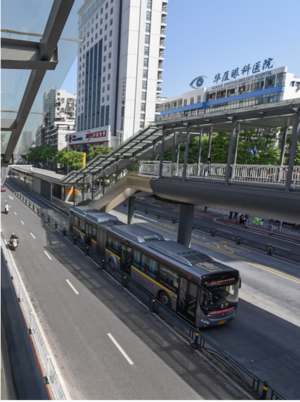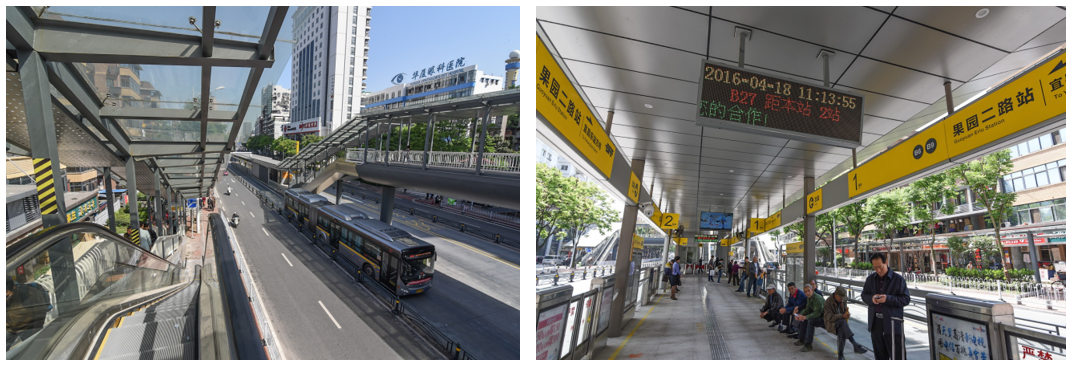Hubei-Yichang Sustainable Urban Transport Project: Bus Rapid Transit System (Yichang, China)

Area: periurban
Date implemented: July 2015 (first route open), February 2018 (full implementation)
How long from concept to implementation: 3.5 years (first route open), 6 years (full implementation)
Relation between efforts undertaken and benefits achieved: good
What was done and how: A 23.9 km bus rapid transit (BRT) system was built in the median of the main arterial road in Yichang. Services operate from the provincial bus terminal in Yiling District and end at Yichang East railway station. The route connects the main residential and business districts to the city’s new logistics and industrial park and to the high speed railway station. The BRT includes dedicated, centre-running bus lanes, fully enclosed bus stations, a bus management system and bus information system, a fare collection system, and parking management along the BRT corridor. Funding was procured from municipal funds, a domestic state-owned bank (China Development Bank/Industrial and Commercial Bank of China), and a multilateral development bank (Asian Development Bank).
Why it worked to 'fast track' the innovation/measure: Top city leadership was directly involved in the implementation of the project and fully supported it. City leadership ensured that interagency coordination went smoothly. A special institutional setup was used to manage the project. A leading group, with its own headquarters and a Deputy Mayor in charge, was responsible for managing all other players in the project and liaising with funding providers to ensure implementation was in line with requirements.
Lessons learnt: A comprehensive study prior to planning enabled swift action to address the needs of the city, informed the project designs, and helped convince shareholders through evidence-led planning. Strategic, low cost options along major arteries can bring more value than extensive road building to accomodate personal transport options. It is possible to design for social inclusiveness by connecting areas underserved by public transport and sustainable modes to the transport network. Actively engage with citizens and other stakeholders to avoid feelings of alienation common in large-scale projects. Learn from similar existing projects, as well as experts in the field, to increase the efficiency and value of the project. Holistic interventions adressing several issues increase the impact of each single measure.
Tips for replication: Engage in policy dialogue with potential funders: Yichang changed the proposal from one focused on road building within the city to one based on a BRT system following dialogue with the Asian Development Bank. Focus on a wholistic approach using several interlocking measures to tackle an issue.
Sources or links:

Date implemented: July 2015 (first route open), February 2018 (full implementation)
How long from concept to implementation: 3.5 years (first route open), 6 years (full implementation)
Relation between efforts undertaken and benefits achieved: good
What was done and how: A 23.9 km bus rapid transit (BRT) system was built in the median of the main arterial road in Yichang. Services operate from the provincial bus terminal in Yiling District and end at Yichang East railway station. The route connects the main residential and business districts to the city’s new logistics and industrial park and to the high speed railway station. The BRT includes dedicated, centre-running bus lanes, fully enclosed bus stations, a bus management system and bus information system, a fare collection system, and parking management along the BRT corridor. Funding was procured from municipal funds, a domestic state-owned bank (China Development Bank/Industrial and Commercial Bank of China), and a multilateral development bank (Asian Development Bank).
Why it worked to 'fast track' the innovation/measure: Top city leadership was directly involved in the implementation of the project and fully supported it. City leadership ensured that interagency coordination went smoothly. A special institutional setup was used to manage the project. A leading group, with its own headquarters and a Deputy Mayor in charge, was responsible for managing all other players in the project and liaising with funding providers to ensure implementation was in line with requirements.
Lessons learnt: A comprehensive study prior to planning enabled swift action to address the needs of the city, informed the project designs, and helped convince shareholders through evidence-led planning. Strategic, low cost options along major arteries can bring more value than extensive road building to accomodate personal transport options. It is possible to design for social inclusiveness by connecting areas underserved by public transport and sustainable modes to the transport network. Actively engage with citizens and other stakeholders to avoid feelings of alienation common in large-scale projects. Learn from similar existing projects, as well as experts in the field, to increase the efficiency and value of the project. Holistic interventions adressing several issues increase the impact of each single measure.
Tips for replication: Engage in policy dialogue with potential funders: Yichang changed the proposal from one focused on road building within the city to one based on a BRT system following dialogue with the Asian Development Bank. Focus on a wholistic approach using several interlocking measures to tackle an issue.
Sources or links:







